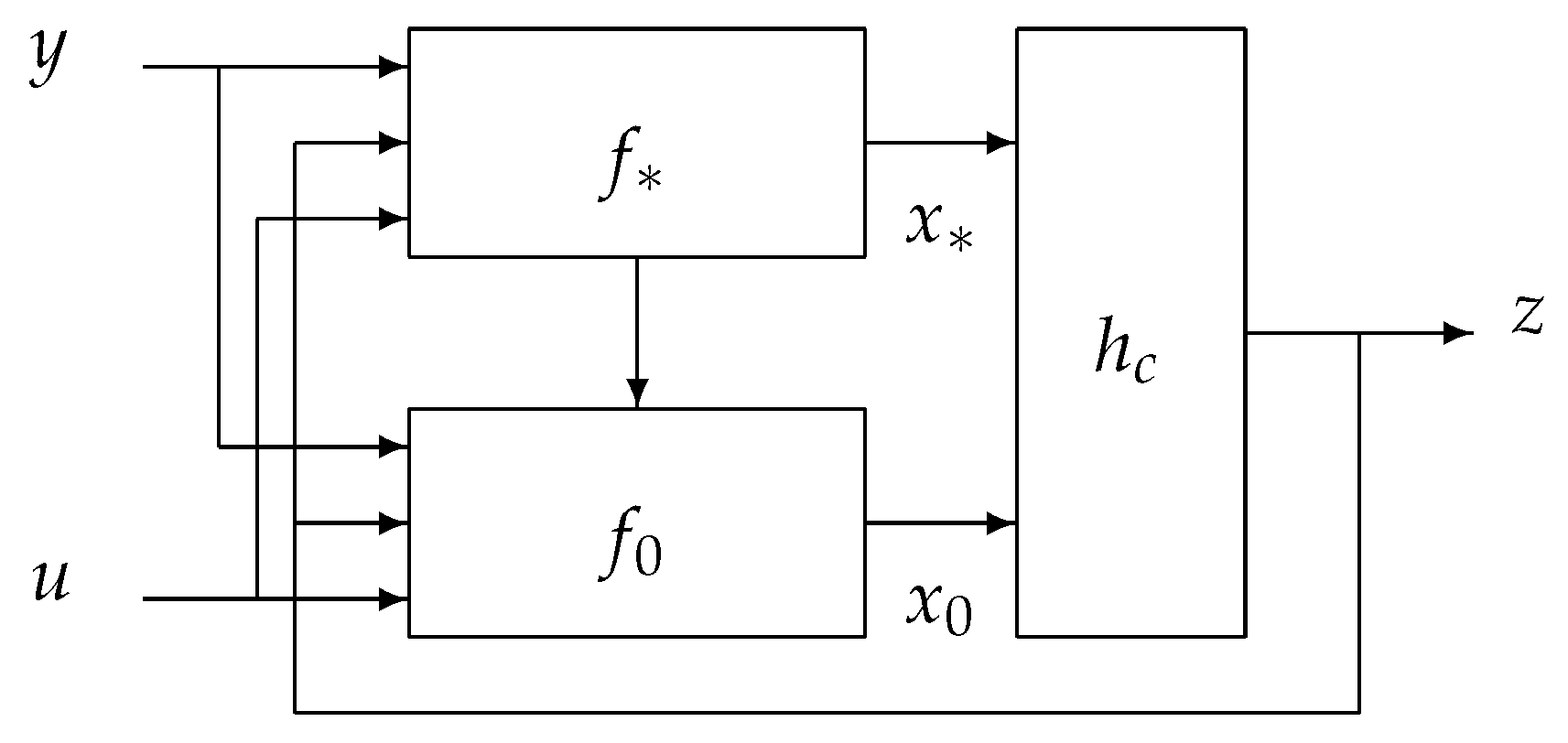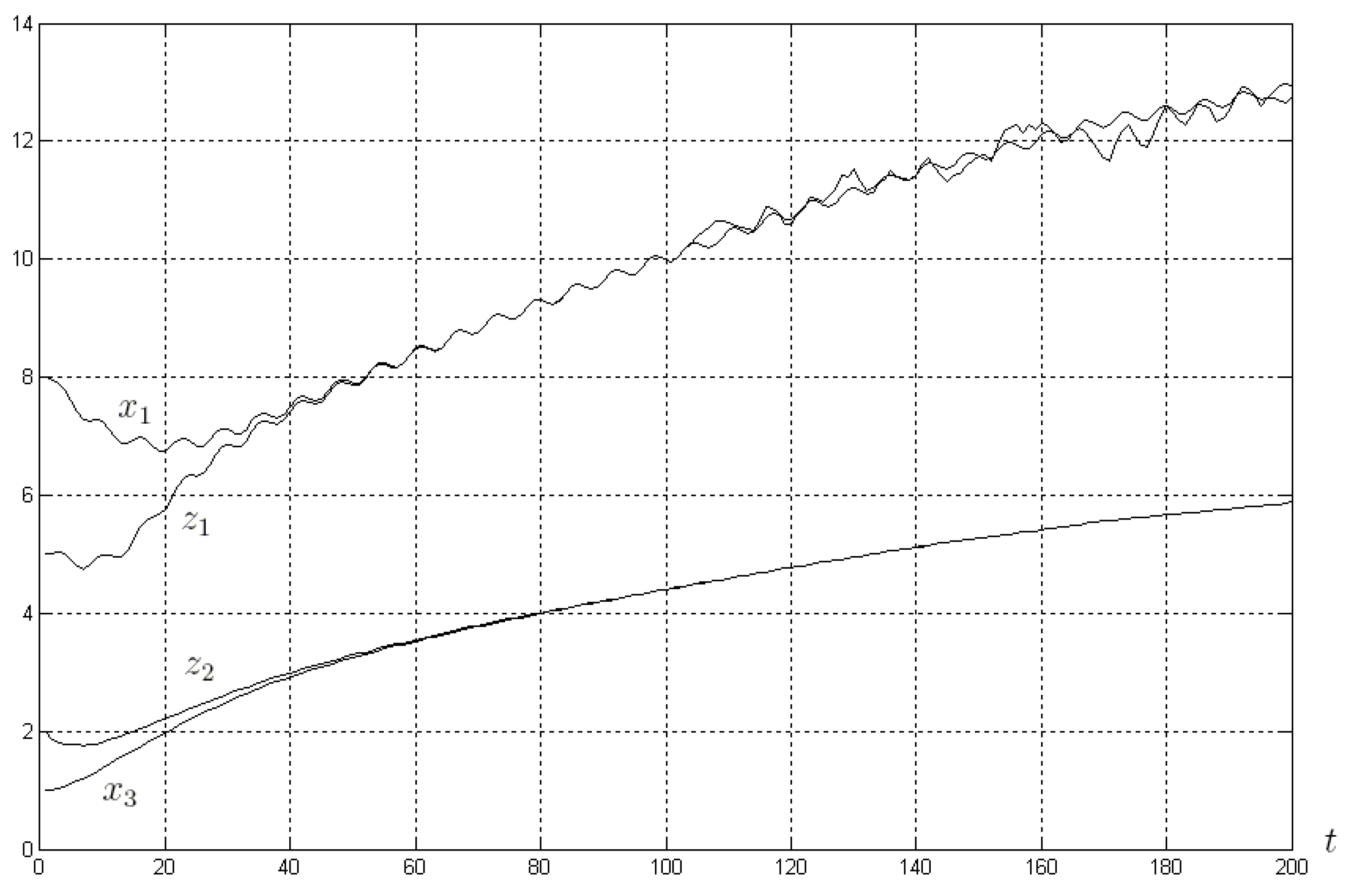Virtual Sensors for Nonlinear Discrete-Time Dynamic Systems
Abstract
1. Introduction
2. General Solution
| Algorithm 1: Computation of the function |
| 1. Set , . |
| 2. Compute the function . |
| 3. If can be expressed via , go to Step 5. |
| 4. Find the function with a minimal number of components satisfying the inequality |
| set and go to Step 2. |
| 5. Set . |
3. Logic-Dynamic-Based Solution
3.1. Insensitivity to the Disturbance
3.2. Sensitive to the Disturbance Solution
4. Stability of the Model
5. Practical Example
6. Discussion
Author Contributions
Funding
Institutional Review Board Statement
Informed Consent Statement
Data Availability Statement
Acknowledgments
Conflicts of Interest
Sample Availability
Appendix A. Algebra of Functions
References
- Ahmed, Q.; Bhatti, A.; Iqbal, M. Virtual sensors for automotive engine sensors fault diagnosis in second-order sliding modes. IEEE Sens. J. 2011, 11, 1832–1840. [Google Scholar] [CrossRef]
- Albertos, P.; Goodwin, G. Virtual sevrors for control application. Annu. Rev. Control. 2002, 26, 101–112. [Google Scholar] [CrossRef]
- Berkhoff, A.; Hekman, T. Active noise control using finite element-based virtual sensors. In Proceedings of the IEEE International Conference on Acoustics, Speech and Signal Processing (ICASSP), Brighton, UK, 12–17 May 2019. [Google Scholar]
- Blanke, M.; Kinnaert, M.; Lunze, J.; Staroswiecki, M. Diagnosis and Fault Tolerant Control; Springer: Berlin, Germany, 2016. [Google Scholar]
- Galavizh, A.; Hassanabadi, A. Designing fuzzy fault tolerant controller for a DC microgrid based on virtual sensor. In Proceedings of the 7th International Conference on Control, Instrumentation and Automation (ICCIA), Tabriz, Iran, 23–24 February 2021. [Google Scholar]
- Hashlamon, I.; Erbatur, K. Joint sensor fault detection and recovery based on virtual sensor for walking legged robots. In Proceedings of the IEEE 23rd International Symposium on Industrial Electronics, ISIE 2014, Istanbul, Turkey, 1–4 June 2014; pp. 1204–1210. [Google Scholar]
- Heredia, G.; Ollero, A. Virtual sensor for failure detection, identification and recovery in the transition phase of a morphing aircraft. Sensors 2010, 10, 2188–2201. [Google Scholar] [CrossRef]
- Jove, E.; Casteleiro-Roca, J.; Quntian, H.; Mendez-Perez, J.; Calvo-Rolle, J. Virtual sensor for fault detection, isolation and data recovery for bicomponent mixing machine monitoring. Informatica 2019, 30, 671–687. [Google Scholar] [CrossRef]
- Luzar, M.; Witczak, M. Fault-tolerant control and diagnosis for LPV system with H-infinity virtual sensor. In Proceedings of the 3rd Conference Control and Fault-Tolerant Systems, Barcelona, Spain, 7–9 September 2016; pp. 825–830. [Google Scholar]
- Trevathan, J.; Read, W.; Sattar, A.; Schmidtke, S.; Sharp, T. The virtual sensor concept. In Proceedings of the 2020 IEEE Sensors, Rotterdam, The Netherlands, 25–28 October 2020. [Google Scholar]
- Wang, Y.; Rotondo, D.; Puig, V.; Cembrano, G. Fault-tolerant control based on virtual actuator and sensor for discrete-time descriptor systems. IEEE Trans. Circuits Syst. 2020, 67, 5316–5325. [Google Scholar] [CrossRef]
- Witczak, M. Fault Diagnosis and Fault Tolerant Control Strategies for Nonlinear Systems; Springer: Berlin, Germany, 2014. [Google Scholar]
- Roy, C.; Roy, A.; Misra, S. DIVISOR: Dynamic virtual sensor formation for overlapping region in IoT-based sensor-cloud. In Proceedings of the 2018 IEEE Wireless Communications and Networking Conference, Barcelona, Spain, 15–18 April 2018. [Google Scholar]
- Hosseinpoor, Z.; Arefi, M.; Razavi-Far, R.; Mozafari, N.; Hazbavi, S. Virtual sensors for fault diagnosis: A case of induction motor broken rotor bar. IEEE Sens. J. 2021, 21, 5044–5051. [Google Scholar] [CrossRef]
- Zhirabok, A.; Shumsky, A. The Algebraic Methods for Analysis of Nonlinear Dynamic Systems; Dalnauka: Vladivostok, Russia, 2018. (In Russian) [Google Scholar]
- Zhirabok, A. Logic-dynamic approach to the fault diagnosis in nonlinear systems. In Fault Diagnosis in Robotic and Industrial Systems; Rigatos, G.G., Ed.; iConcept Press: Hong Kong, China, 2012; pp. 67–88. [Google Scholar]
- Zhirabok, A. Fault isolation in nonlinear systems by functional diagnosis method based on generalized algebraic invariants. Autom. Remote Control 1994, 55, 956–964. [Google Scholar]
- Zhirabok, A. Disturbance decoupling problem: Logic-dynamic approach-based solution. Symmetry 2019, 11, 555. [Google Scholar] [CrossRef]
- Kaldmae, A.; Kotta, U.; Jiang, B.; Shumsky, A.; Zhirabok, A. Faulty plant reconfiguration based on disturbance decoupling methods. Asian J. Control 2016, 8, 858–867. [Google Scholar]
- Isidori, A. The geometric approach to nonlinear feedback control. Lect. Notes Comput. Inf. Sci. 1982, 44, 517–530. [Google Scholar]
- Zhirabok, A.; Shumsky, A.; Solyanik, S.; Suvorov, A. Design of nonlinear robust diagnostic observers. Autom. Remote Control 2017, 78, 1572–1584. [Google Scholar] [CrossRef]
- Misawa, E.; Hedrick, J. Nonlinear observers—A state of the art. Survey. J. Dyn. Syst. Meas. Control. 1989, 111, 344–352. [Google Scholar] [CrossRef]
- Aranda-Brivaire, E.; Kotta, U. A geometric solution to the dynamic disturbance decoupling for discrete-time nonlinear systems. Kybernetika 2004, 40, 197–206. [Google Scholar]
- Zhirabok, A.; Zuev, A.; Filaretov, V.; Shumsky, A.; Kim, C. Jordan canonical form in the diagnosis and estimation problems. Autom. Remote Control 2022, 83, 1355–1370. [Google Scholar] [CrossRef]
- Jiang, X.; Zhao, D. Event-triggered fault detection for nonlinear discrete-time switched stochastic systems: A convex function method. Sci. China Inf. Sci. 2021, 64, 200204. [Google Scholar] [CrossRef]
- Zhang, T.; Deng, F.; Sun, Y.; Shi, P. Fault estimation and fault-tolerant control for linear discrete time-varying stochastic systems. Sci. China Inf. Sci. 2021, 64, 200201. [Google Scholar] [CrossRef]
- Gratzer, G. General Lattice Theory; Akademie-Verlag: Berlin, Germany, 1978. [Google Scholar]
- Shumsky, A.; Zhirabok, A. Unified approach to the problem of full decoupling via output feedback. Eur. J. Control 2010, 16, 313–325. [Google Scholar] [CrossRef]


Disclaimer/Publisher’s Note: The statements, opinions and data contained in all publications are solely those of the individual author(s) and contributor(s) and not of MDPI and/or the editor(s). MDPI and/or the editor(s) disclaim responsibility for any injury to people or property resulting from any ideas, methods, instructions or products referred to in the content. |
© 2023 by the authors. Licensee MDPI, Basel, Switzerland. This article is an open access article distributed under the terms and conditions of the Creative Commons Attribution (CC BY) license (https://creativecommons.org/licenses/by/4.0/).
Share and Cite
Sergiyenko, O.; Zhirabok, A.; Hameed, I.A.; Azar, A.T.; Zuev, A.; Filaretov, V.; Tyrsa, V.; Ibraheem, I.K. Virtual Sensors for Nonlinear Discrete-Time Dynamic Systems. Symmetry 2023, 15, 993. https://doi.org/10.3390/sym15050993
Sergiyenko O, Zhirabok A, Hameed IA, Azar AT, Zuev A, Filaretov V, Tyrsa V, Ibraheem IK. Virtual Sensors for Nonlinear Discrete-Time Dynamic Systems. Symmetry. 2023; 15(5):993. https://doi.org/10.3390/sym15050993
Chicago/Turabian StyleSergiyenko, Oleg, Alexey Zhirabok, Ibrahim A. Hameed, Ahmad Taher Azar, Alexander Zuev, Vladimir Filaretov, Vera Tyrsa, and Ibraheem Kasim Ibraheem. 2023. "Virtual Sensors for Nonlinear Discrete-Time Dynamic Systems" Symmetry 15, no. 5: 993. https://doi.org/10.3390/sym15050993
APA StyleSergiyenko, O., Zhirabok, A., Hameed, I. A., Azar, A. T., Zuev, A., Filaretov, V., Tyrsa, V., & Ibraheem, I. K. (2023). Virtual Sensors for Nonlinear Discrete-Time Dynamic Systems. Symmetry, 15(5), 993. https://doi.org/10.3390/sym15050993








